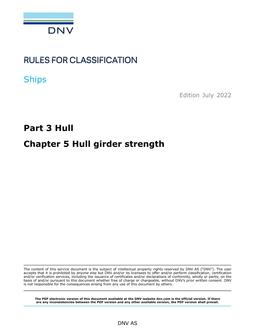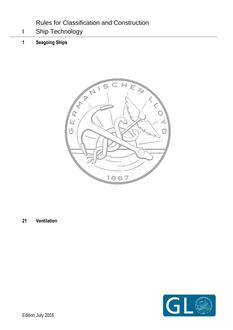-
-
Available Formats
- Availability
- Priced From ( in USD )
-
Available Formats
-
- Secure PDF 🔒
- Immediate download
- $57.00
- Add to Cart
-
- Printed Edition
- Ships in 1-2 business days
- $57.00
- Add to Cart
Customers Who Bought This Also Bought
-

DNV DNV TAP NO. 843.30-MED A.1/4.7
Priced From $57.00 -

DNV DNV-RU-SHIPS PART 3 CHAPTER 5
Priced From $57.00 -

DNV DNV-RU-UWT PART 1 CHAPTER 1
Priced From $57.00 -

DNV GL SHIP TECHNOLOGY I-1-21
Priced From $57.00
About This Item
Full Description
Scope and basic principles
The gear rating procedures given in this class guideline are mainly based on the ISO6336 Part 1 to 5 (cylindrical gears), and partly on ISO 10300 Part 1 to 3 (bevel gears) and ISO Technical Reports on Scuffing and Fatigue Damage Accumulation, but especially applied for marine purposes, such as marine propulsion and important auxiliaries onboard ships and mobile offshore units.
The calculation procedures cover gear rating as limited by contact stresses (pitting, spalling or case crushing), tooth root stresses (fatigue breakage or overload breakage), and scuffing resistance. Even though no calculation procedures for other damages such as wear, grey staining (micropitting), etc. are given, such damages may limit the gear rating.
The class guideline applies to enclosed parallel shaft gears, epicyclic gears and bevel gears (with intersecting axis). However, open gear trains may be considered with regard to tooth strength, i.e. part 1 and 3 may apply. Even pinion-rack tooth strength may be considered, but since such gear trains often are designed with non-involute pinions, the calculation procedure of pinion-racks is described in Appendix C.
Steel is the only material considered.
The methods applied throughout this document are only valid for a transverse contact ratio 1 < εα< 2. If εα > 2, either special considerations shall be made, or suggested simplification may be used.
All influence factors are defined regarding their physical interpretation. Some of the influence factors are determined by the gear geometry or have been established by conventions. These factors shall be calculated in accordance with the equations provided. Other factors are approximations, which are clearly stated in the text by terms as «may be calculated as». These approximations are substitutes for exact evaluations where such are lacking or too extensive for practical purposes, or factors based on experience. In principle, any suitable method may replace these approximations.
Bevel gears are calculated on basis of virtual (equivalent) cylindrical gears using the geometry of the midsection. The virtual (helical) cylindrical gear shall be calculated by using all the factors as a real cylindrical gear with some exceptions. These exceptions are mentioned in connection with the applicable factors. Wherever a factor or calculation procedure has no reference to either cylindrical gears or bevel gears, it is generally valid, i.e. combined for both cylindrical and bevel.
In order to minimise the volume of this class guideline such combinations are widely used, and everywhere it is necessary to distinguish, it is clearly pointed out by local headings such as:
— cylindrical gears
— bevel gears
The permissible contact stresses, tooth root stresses and scuffing load capacity depend on the safety factors as required in the respective rule sections.
Terms as endurance limit and static strength are used throughout this class guideline.
Endurance limit shall be understood as the fatigue strength in the range of cycles beyond the lower knee of the σ–N curves, regardless if it is constant or drops with higher number of cycles.
Static strength shall be understood as the fatigue strength in the range of cycles less than at the upper knee of the σ–N curves.
For gears that are subjected to a limited number of cycles at different load levels, a cumulative fatigue calculation applies. Information on this is given in Appendix A.
When the term infinite life is used, it means number of cycles in the range 108 to 1010.





